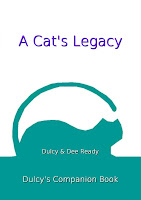Way back in April 1991, a Minnesota
friend helped me realize that the words Dulcy had given me after her death were
too plentiful. However, trying to determine just what to cut flummoxed both of us. I needed help, but where was I to get it?
The
answer came as a result of a query letter I sent to a senior editor at Crown
Publishing, which is part of the Random House conglomerate. With the query
letter, I sent five of the manuscript’s chapters in an attempt to whet her
interest for reading the entire twenty-six chapters.
Within
two weeks the editor got back to me. If I’d be willing to cut the book in half—from
42,000 words to about 20,000—she’d be willing to read the completed manuscript. As to what to cut, this astute editor suggested I delete all the words, stories, and incidents that had nothing to do
with the relationship Dulcy and I had forged over seventeen and a half years of
living together.
That word—relationship—delineated the essence of Dulcy’s first book, A
Cat’s Life: Dulcy’s Story, which was published in 1992 and which contained
about 20,000 words.
Twenty
years later, in May 2012, Wayman Publishing published another book in which Dulcy spoke:
Twelve Habits of Highly Successful Cats
and Their Humans. However, only a few copies of the book sold throughout
the summer months.
I didn't know what the problem was. A Cat's Life had sold reasonably well. Why not Twelve Habits? I thought perhaps the format was at fault because I was unsure of my own writing within the book. However, several bloggers reviewed it and seemed to like both Dulcy's words and mine. So what was wrong?
Today—some eight months later—I think I’ve finally gotten my
act together with regard to this second book. Here’s
the odyssey that book has taken:
In
September 2012, one of Dulcy’s fans—Inger of Desert Canyon Living—suggested
that the book’s title didn’t do justice to its contents. That resulted in a new title, suggested
by Inger, as well as a new cover. The new title? A Cat's Legacy: Dulcy's Story.
In
the following two months, Wayman Publishing and I changed the cover two more
times. Why? Because the book still wasn’t selling well in either its print or
e-book version. So within six months, Wayman and I had two titles and four
covers—all because I hadn’t spent time, initially, determining the book’s
reason for being.
Here are
the four covers.
Still
the book didn’t sell. Now the truth is that writers want to make some profit on their books, even though perhaps their greatest desire is simply to be read. Living on a fixed income, I'd delight in making a little more discretionary money. So I've hoped for many months that this second book would begin to sell.
It
was the senior editor at Wayman who helped me find my way with A Cat's Legacy. With the third cover, she began to call it “Dulcy’s Companion Book.”
Then my great-niece Brandi told me what she thought the book still needed—both a title AND a cover that would show its relationship to the first book in which Dulcy spoke. Note
that word again—relationship!
Finally,
the light dawned. What the book lacked was visual evidence that it was another
Dulcy book; that it was the second book in a series. I also realized that with
this second book, I played a more major role. Thus, I decided to add myself to the cover.
My
niece, who is majoring in photography in college, designed a new—AND
FINAL!!!!!—cover for me. Here it is:
If
you have time, please go to Amazon and look up Dee Ready. The site will take you to the various books that have been published with my name on or in them. There's you'll see A Cat's Legacy above A Cat's Life. That view pleases me mightily. How about
you? Do you like the new cover? Do you think it will attract readers?









